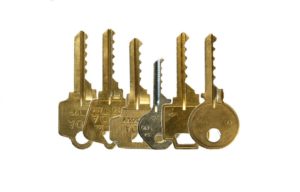Bump Key
Maybe you’ve heard the term, “bump key” before and wondered what is a bump key, how do you make it, and what makes a lock bump proof?
What is a Bump Key?
 Bump keys are keys that are specially cut to take advantage of the mechanics of pin tumbler locks. They are often used by first responders and security personnel to gain entry when picking a lock is impractical or not possible. They are also used by criminals to break into offices and homes. Some research indicates that nearly every conventional business or home lock is susceptible to being opened by a bump key attack.
Bump keys are keys that are specially cut to take advantage of the mechanics of pin tumbler locks. They are often used by first responders and security personnel to gain entry when picking a lock is impractical or not possible. They are also used by criminals to break into offices and homes. Some research indicates that nearly every conventional business or home lock is susceptible to being opened by a bump key attack.
Bump keys work on pin tumbler locks which contain key pins and driver pins located within the core and cylinder of the lock. In the locked position, the key pins and driver pins occupy the same pinhole and are pushed together by a spring that prevents the rotation of the core. When you insert a key that is cut for that specific lock, the grooves on the key push the pins into alignment along the shear line which allows you to rotate the core and retract any bolt work which unlocks the lock and allows you to open your door. Aligning these pins to allow a separation between the key pin and the driver pin to align with the separation between the core and housing creates a shear line. This shear line allows the core to rotate within the lock cylinder. If you insert the wrong key, the gap between the pins will not line up properly with the core and will not create a shear line which will prevent the core from rotating, and the door will remain locked.
A bump key is key works on the same basic idea as a lock pick gun. The bump key is cut with low peaks and wide valleys in the groves. To open a lock, you partially insert the bump key into the lock and then you bump the key by applying force with a hammer or blunt object. This bump forces the key deeper into the lock and causes the key pins to the jar and the driver pins to move just enough to create a shear line that allows the user to quickly turn the key, turning the core and unlocking the lock.
For how to make a bump key video instructions click here
How Do You Make a Bump Key?
Theoretically, a bump key can be made at home using a file. However, this can be difficult and tedious. First, a bump key must be made from a key that is similar to the key that fits the lock you are trying to bump. The easiest way to make a bump key is to buy a bump key set from a hardware store or online. If you want to try to make your own, you will need a set of blank keys that fit the specific style of lock you want to open, a depth or spacing guide for your lock manufacturer’s keys, or a digital caliper to measure depth and spacing, and a triangular, taper file, or a key clipper. After making the first cut using the first value, each subsequent cut should be spaced at equal intervals and never go below the indented line on the key. It’s going to require a great deal of filing, effort, a bit of precision and time. Make sure the angle of your cuts are shallow enough to allow for smooth insertion and removal of the key.
What Makes a Lock Bump Proof
For a lock to completely bump proof, it must have no keyhole or a locking mechanism that is designed to specifically bump proof. The safest way to make sure your lock is bump proof is to get a deadbolt without a keyhole. There are locks that open by using a personal code that you enter into a number pad, turn the knob, and the lock unlocks. The best part is that it is completely bumps proof because it doesn’t use a keyhole to open it. There are also locks that have a keyhole but provide you with a bump stop cylinder that uses a special pin inside the lock to prevent the pins from jumping from a bump making the cylinder unable to turn, which in turn makes the lock stay locked and unable to bump.
Our Expert Locksmith Lenexa team has provided us with the above information explains what is a bump key, how do you make it, and what makes a lock bump proof? Like any tool, a bump key can be used for purposes of good intent, for first responders and security to get to you when you need it most, but it can also end up in the hands of those who want to break into a home or business for bad intent. Remember, that in the hands of someone who isn’t accustomed to using this kind of key, it can leave damage to your lock. Make sure your locks are bump proof and secure by contacting a professional locksmith to evaluate and recommend the best locks for your home and business.
